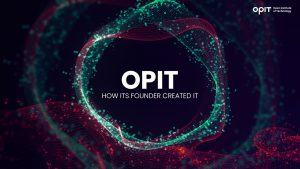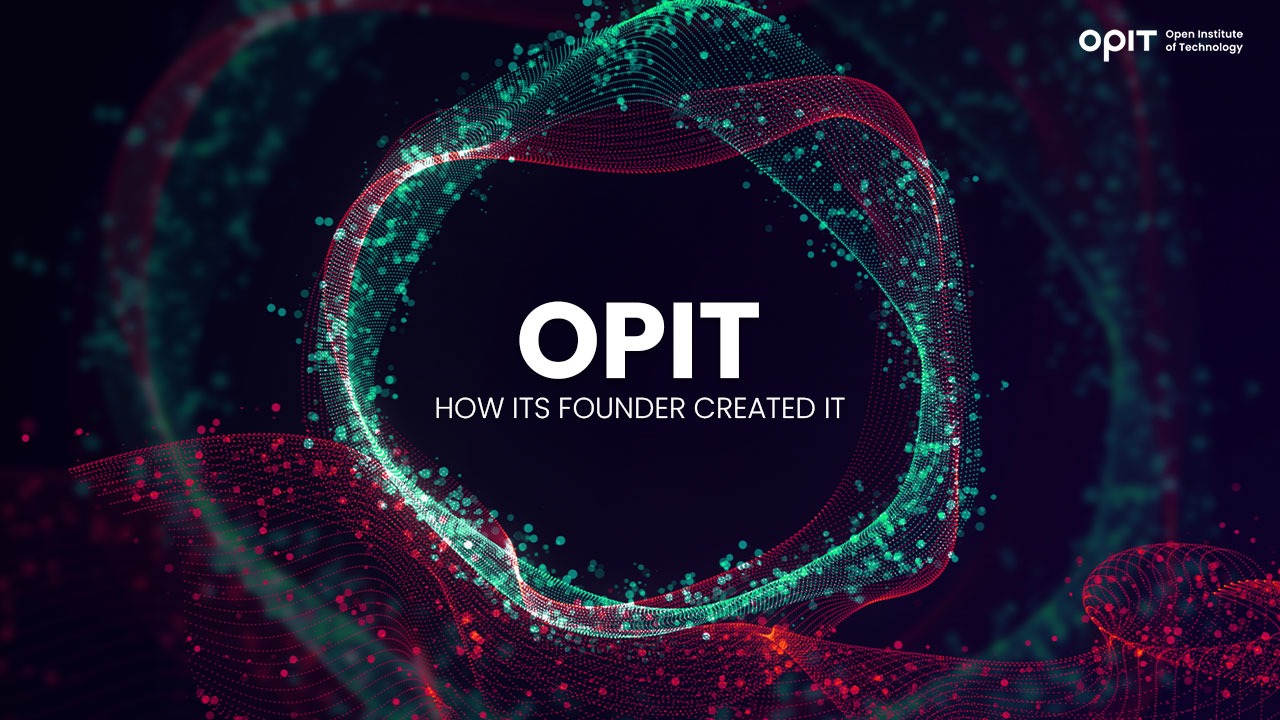

The Open Institute of Technology (OPIT) is a unique institution through and through. From an unparalleled support team that guides you every step of the way to state-of-the-art virtual resources, OPIT redefines online learning. This institution also proves that online education can be as enriching as its traditional counterpart. Better yet, it can outperform it in numerous aspects.
This fact alone begs the question – how did it all begin?
To answer this question, we’ll go straight to the source – the founder of OPIT, Riccardo Ocleppo.
In this article, Riccardo will walk us through his journey of envisioning (and building) OPIT and transforming online education in the process.
The Pre-OPIT Years: Where It All Began
To understand how Riccardo came up with the idea for OPIT, we must travel back to the year 2006. That’s when Riccardo graduated from Politecnico di Torino with a bachelor’s in electronics engineering.
This institution is arguably the most prestigious in Italy (and one of the most reputable in Europe). So, it shouldn’t be surprising that Riccardo chose to continue his education here, pursuing a master’s degree.
He completed the master’s program in 2008 and did so with honors.
Yet, Riccardo couldn’t shake the impression that it was all in vain. In his words, “When I left the university, I had the impression that I could do very little, and I knew very little that could help me in my professional endeavors.”
But Riccardo decided not to sit idly by.
He saw it this way – it might be too late for him, as he was done with his studies. But it’s certainly not too late for future students who deserve a better education. That’s why, only two years later, in 2010, he founded Docsity.
Docsity is an online social learning network with over 20 million registered students. Thanks to this network, over 250 universities worldwide received help in improving their study programs (and finding students).
Docsity also gave Riccardo a chance to fully immerse himself into the education sector for over a decade, finding new ways to reform it from within.
OPIT’s Inception: From Vision to Reality
With the knowledge (and the resources) from Docsity, Riccardo started working on a platform designed to provide the kind of education he wished he had received. The platform in question was, of course, the Open Institute of Technology.
The primary goal of OPIT was to bridge the gap between “what students expect, what companies need, and what higher-level institutions actually deliver in terms of training and education.”
From Riccardo’s experience, this gap was pretty huge. Remember that even with a bachelor’s and a master’s degree in electronics engineering, he felt he had little to offer to companies.
This perceived shortcoming primarily comes from the fact he received a lot of theory at the university but very little practice. And that’s not to mention how outdated the curriculum was, as well as laser-focused on electronics engineering. In other words, bid farewell to “competencies on the most recent technologies and project management methodologies.”
This perspective made him determined to create a holistic educational solution. Or, as Riccardo puts it, “When designing OPIT’s degree programs to address the skills in high demand today, we chose to start from scratch to go beyond the limits of traditional higher education.”
At OPIT, you’ll receive valuable knowledge beyond theory. Essentially, OPIT equips you with everything you need to enter the job market, ready to excel in your field from day one (or day zero, as Riccardo calls it!).
Tailored for Triumph: OPIT’s Unique Programs
Designing any online curriculum is no easy task. However, the computer science field comes with its unique set of challenges. Why?
This field is constantly evolving. That’s what makes it difficult for most traditional higher education institutions to keep up. As Riccardo puts it, “[These institutions] are very slow to adapt to this wave of new technologies and new trends within the educational sector.” Of course, thanks to Docsity, Riccardo speaks from extensive experience, as he’s seen “multiple times how difficult it is to help these institutions update their study curriculum.”
Companies have it no easier.
Riccardo says, “A company needs one to two years to make people that should be trained on today’s technologies and on today’s skills effectively enter the job market and be productive when they enter these companies.”
Again, Riccardo speaks from personal experience. As a founder of a tech company (and a manager in others), he was tasked with creating and managing big tech teams on several occasions. However, despite interviewing hundreds of candidates, he couldn’t find those trained in today’s technologies, not those from 20 years ago.
With this in mind, he designed OPIT’s curriculum to effectively “train the next generation of leaders and managers in the field of computer science.” Many people helped him in this endeavor, chief among them Professor Francesco Profumo, current head of institution at OPIT and former Minister of Education in Italy.
This unique approach makes OPIT’s programs different in terms of how they’ve been conceived and how they’ll be delivered.
Take the Bachelor of Science (BSc) in Modern Computer Science program as an example.
Riccardo says that to be a great programmer, “you cannot just dive into programming itself.” First, you must understand how a computer is built and how its various units operate and communicate. This way, you’ll have no issues debugging a code in the future since you’ll understand the underlying mechanisms.
These underlying systems and foundational skills are precisely what is taught during the first term of the modern computer science program. Afterward, you’ll move toward the latest advancements in computer science, including machine learning, artificial intelligence, data science, cybersecurity, and cloud computing. This way, you’ll have quite a broad perspective on computer science, rarely seen in other educational programs, online or offline.
It also means you won’t have to specialize in a particular field, as you’re forced to do with many other programs. In Riccardo’s opinion, the master’s degree is where you should begin your specialization journey.
OPIT offers as many as four master’s degree programs, but Riccardo focuses on Applied Data Science & AI this time.
In Riccardo’s words, “The whole purpose of this [program] is actually to train people that do not want to pursue a super technical career but actually want to pursue a career at the intersection between the tech and the management of a company.” In other words, individuals who complete this program will acquire all the necessary tech skills. However, they’ll also be able to ensure the tech team is “correctly understood by the management of the company,” thanks to the managerial skills earned during the program.
Of course, this program also covers all the essential theoretical knowledge, from Python to machine learning. But it also has a solid applicative angle, teaching students how to use the most valuable tools available in today’s market. Simply put, you’re training “for what you’ll be doing when you enter your next job.”
Breaking the Mold: What Sets OPIT Apart
The unique curriculum isn’t the only thing that sets OPIT apart from other higher education institutions in the same field. Here’s what Riccardo singles out as OPIT’s most appealing characteristics.
Continuous Assessment
Learning at your own pace can be a double-edged sword. On the one hand, you have all the flexibility and freedom to organize your studies (and life). On the other, you might start procrastinating without a traditional daily commitment of in-classroom learning.
OPIT ensures this unfortunate scenario never happens by doing away with one big final exam you must cram for. Instead, you’ll be continuously assessed throughout the program, allowing you a much better approach to learning and a deeper understanding of the subject matter.
As Riccardo puts it, OPIT will give you “multiple checkpoints,” preventing you from getting “lost” throughout the learning process.
New Learning Resources
According to Riccardo, most of today’s available resources were created for the “oldest wave of education.” That’s why he (and his team) created all OPIT resources and learning materials from scratch, giving you a fresh perspective on the tech world. These resources also come in the form of engaging videos, which are short enough to keep you fully focused yet detailed enough to provide a deep understanding of the topic.
World-Class Professors
Let’s not sugarcoat it – modern resources mean nothing if the professors teaching them still stick to old-school principles and approaches. Luckily, this isn’t the case with OPIT’s faculty.
Every member of this faculty has been carefully selected based on their academic expertise, business experience, and global perspective. These professors aim to “help you learn in a more engaging and interesting way,” as Riccardo puts it.
He also adds that OPIT’s faculty breaks away from the common saying in academics, “Those who can’t do, teach.” In his words, “We didn’t want to have people that can teach because they cannot do,” so that’s the standard he prioritized when bringing people on board.
Future-Proof Your Career
Now that you know the fascinating tale of OPIT’s conception, all that’s left to do is to get in touch with our team of experts and take the first step in future-proofing your career. As you’ve already seen, OPIT will take care of most of the subsequent steps. All you need is a desire to learn and an interest in developing new skills, and success is imminent.
Related posts

Source:
- Agenda Digitale, published on November 25th, 2025
In recent years, the word ” sustainability ” has become a firm fixture in the corporate lexicon. However, simply “doing no harm” is no longer enough: the climate crisis , social inequalities , and the erosion of natural resources require a change of pace. This is where the net-positive paradigm comes in , a model that isn’t content to simply reduce negative impacts, but aims to generate more social and environmental value than is consumed.
This isn’t about philanthropy, nor is it about reputational makeovers: net-positive is a strategic approach that intertwines economics, technology, and corporate culture. Within this framework, digitalization becomes an essential lever, capable of enabling regenerative models through circular platforms and exponential technologies.
Blockchain, AI, and IoT: The Technological Triad of Regeneration
Blockchain, Artificial Intelligence, and the Internet of Things represent the technological triad that makes this paradigm shift possible. Each addresses a critical point in regeneration.
Blockchain guarantees the traceability of material flows and product life cycles, allowing a regenerated dress or a bottle collected at sea to tell their story in a transparent and verifiable way.
Artificial Intelligence optimizes recovery and redistribution chains, predicting supply and demand, reducing waste and improving the efficiency of circular processes .
Finally, IoT enables real-time monitoring, from sensors installed at recycling plants to sharing mobility platforms, returning granular data for quick, informed decisions.
These integrated technologies allow us to move beyond linear vision and enable systems in which value is continuously regenerated.
New business models: from product-as-a-service to incentive tokens
Digital regeneration is n’t limited to the technological dimension; it’s redefining business models. More and more companies are adopting product-as-a-service approaches , transforming goods into services: from technical clothing rentals to pay-per-use for industrial machinery. This approach reduces resource consumption and encourages modular design, designed for reuse.
At the same time, circular marketplaces create ecosystems where materials, components, and products find new life. No longer waste, but input for other production processes. The logic of scarcity is overturned in an economy of regenerated abundance.
To complete the picture, incentive tokens — digital tools that reward virtuous behavior, from collecting plastic from the sea to reusing used clothing — activate global communities and catalyze private capital for regeneration.
Measuring Impact: Integrated Metrics for Net-Positiveness
One of the main obstacles to the widespread adoption of net-positive models is the difficulty of measuring their impact. Traditional profit-focused accounting systems are not enough. They need to be combined with integrated metrics that combine ESG and ROI, such as impact-weighted accounting or innovative indicators like lifetime carbon savings.
In this way, companies can validate the scalability of their models and attract investors who are increasingly attentive to financial returns that go hand in hand with social and environmental returns.
Case studies: RePlanet Energy, RIFO, and Ogyre
Concrete examples demonstrate how the combination of circular platforms and exponential technologies can generate real value. RePlanet Energy has defined its Massive Transformative Purpose as “Enabling Regeneration” and is now providing sustainable energy to Nigerian schools and hospitals, thanks in part to transparent blockchain-based supply chains and the active contribution of employees. RIFO, a Tuscan circular fashion brand, regenerates textile waste into new clothing, supporting local artisans and promoting workplace inclusion, with transparency in the production process as a distinctive feature and driver of loyalty. Ogyre incentivizes fishermen to collect plastic during their fishing trips; the recovered material is digitally tracked and transformed into new products, while the global community participates through tokens and environmental compensation programs.
These cases demonstrate how regeneration and profitability are not contradictory, but can actually feed off each other, strengthening the competitiveness of businesses.
From Net Zero to Net Positive: The Role of Massive Transformative Purpose
The crucial point lies in the distinction between sustainability and regeneration. The former aims for net zero, that is, reducing the impact until it is completely neutralized. The latter goes further, aiming for a net positive, capable of giving back more than it consumes.
This shift in perspective requires a strong Massive Transformative Purpose: an inspiring and shared goal that guides strategic choices, preventing technology from becoming a sterile end. Without this level of intentionality, even the most advanced tools risk turning into gadgets with no impact.
Regenerating business also means regenerating skills to train a new generation of professionals capable not only of using technologies but also of directing them towards regenerative business models. From this perspective, training becomes the first step in a transformation that is simultaneously cultural, economic, and social.
The Regenerative Future: Technology, Skills, and Shared Value
Digital regeneration is not an abstract concept, but a concrete practice already being tested by companies in Europe and around the world. It’s an opportunity for businesses to redefine their role, moving from mere economic operators to drivers of net-positive value for society and the environment.
The combination of blockchain, AI, and IoT with circular product-as-a-service models, marketplaces, and incentive tokens can enable scalable and sustainable regenerative ecosystems. The future of business isn’t just measured in terms of margins, but in the ability to leave the world better than we found it.

Source:
- Raconteur, published on November 06th, 2025
Many firms have conducted successful Artificial Intelligence (AI) pilot projects, but scaling them across departments and workflows remains a challenge. Inference costs, data silos, talent gaps and poor alignment with business strategy are just some of the issues that leave organisations trapped in pilot purgatory. This inability to scale successful experiments means AI’s potential for improving enterprise efficiency, decision-making and innovation isn’t fully realised. So what’s the solution?
Although it’s not a magic bullet, an AI operating model is really the foundation for scaling pilot projects up to enterprise-wide deployments. Essentially it’s a structured framework that defines how the organisation develops, deploys and governs AI. By bringing together infrastructure, data, people, and governance in a flexible and secure way, it ensures that AI delivers value at scale while remaining ethical and compliant.
“A successful AI proof-of-concept is like building a single race car that can go fast,” says Professor Yu Xiong, chair of business analytics at the UK-based Surrey Business School. “An efficient AI technology operations model, however, is the entire system – the processes, tools, and team structures – for continuously manufacturing, maintaining, and safely operating an entire fleet of cars.”
But while the importance of this framework is clear, how should enterprises establish and embed it?
“It begins with a clear strategy that defines objectives, desired outcomes, and measurable success criteria, such as model performance, bias detection, and regulatory compliance metrics,” says Professor Azadeh Haratiannezhadi, co-founder of generative AI company Taktify and professor of generative AI in cybersecurity at OPIT – the Open Institute of Technology.
Platforms, tools and MLOps pipelines that enable models to be deployed, monitored and scaled in a safe and efficient way are also essential in practical terms.
“Tools and infrastructure must also be selected with transparency, cost, and governance in mind,” says Efrain Ruh, continental chief technology officer for Europe at Digitate. “Crucially, organisations need to continuously monitor the evolving AI landscape and adapt their models to new capabilities and market offerings.”
An open approach
The most effective AI operating models are also founded on openness, interoperability and modularity. Open source platforms and tools provide greater control over data, deployment environments and costs, for example. These characteristics can help enterprises to avoid vendor lock-in, successfully align AI to business culture and values, and embed it safely into cross-department workflows.
“Modularity and platformisation…avoids building isolated ‘silos’ for each project,” explains professor Xiong. “Instead, it provides a shared, reusable ‘AI platform’ that integrates toolchains for data preparation, model training, deployment, monitoring, and retraining. This drastically improves efficiency and reduces the cost of redundant work.”
A strong data strategy is equally vital for ensuring high-quality performance and reducing bias. Ideally, the AI operating model should be cloud and LLM agnostic too.
“This allows organisations to coordinate and orchestrate AI agents from various sources, whether that’s internal or 3rd party,” says Babak Hodjat, global chief technology officer of AI at Cognizant. “The interoperability also means businesses can adopt an agile iterative process for AI projects that is guided by measuring efficiency, productivity, and quality gains, while guaranteeing trust and safety are built into all elements of design and implementation.”
A robust AI operating model should feature clear objectives for compliance, security and data privacy, as well as accountability structures. Richard Corbridge, chief information officer of Segro, advises organisations to: “Start small with well-scoped pilots that solve real pain points, then bake in repeatable patterns, data contracts, test harnesses, explainability checks and rollback plans, so learning can be scaled without multiplying risk. If you don’t codify how models are approved, deployed, monitored and retired, you won’t get past pilot purgatory.”
Of course, technology alone can’t drive successful AI adoption at scale: the right skills and culture are also essential for embedding AI across the enterprise.
“Multidisciplinary teams that combine technical expertise in AI, security, and governance with deep business knowledge create a foundation for sustainable adoption,” says Professor Haratiannezhadi. “Ongoing training ensures staff acquire advanced AI skills while understanding associated risks and responsibilities.”
Ultimately, an AI operating model is the playbook that enables an enterprise to use AI responsibly and effectively at scale. By drawing together governance, technological infrastructure, cultural change and open collaboration, it supports the shift from isolated experiments to the kind of sustainable AI capability that can drive competitive advantage.
In other words, it’s the foundation for turning ambition into reality, and finally escaping pilot purgatory for good.
Have questions?
Visit our FAQ page or get in touch with us!
Write us at +39 335 576 0263
Get in touch at hello@opit.com
Talk to one of our Study Advisors
We are international
We can speak in:


